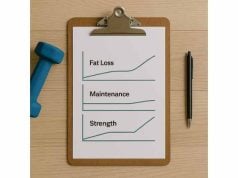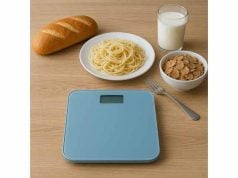
When sleep runs short, fat loss gets harder than the math suggests. Appetite rises, daily movement drops, and water retention masks progress on the scale. Cortisol—the body’s stress signal—shifts its rhythm, nudging you toward quick calories and making workouts feel heavier. The fix is not a new fat-burner or a stricter deficit. It is a plan to repay sleep debt, stabilize your schedule, and reclaim training quality. This guide explains what sleep debt and cortisol actually do, how to adjust food and training when nights are uneven, and when to involve your clinician. If you are troubleshooting a plateau or moving into maintenance, see our structured plateau and maintenance troubleshooting for step-by-step support.
Table of Contents
- What sleep debt does to fat loss
- Cortisol, hunger and water retention
- Repay sleep debt step by step
- Training when sleep is short
- Night habits that drive hunger
- Who should seek medical help
- Evidence and numbers at a glance
- Frequently Asked Questions
What sleep debt does to fat loss
Sleep debt is the gap between the sleep you need and the sleep you actually get, accumulated across days. It acts like compound interest on your physiology: the longer it persists, the more it nudges appetite, movement, mood, and training in the wrong direction for fat loss.
Why fat loss stalls when you are underslept
- Hunger and satiety signals drift. Short nights raise hunger and weaken fullness. People commonly eat 200–400 extra calories on sleep-restricted days, especially from snacks and refined carbs. Protein foods look less appealing; quick energy becomes tempting.
- NEAT quietly drops. Non-exercise activity—fidgeting, posture shifts, errands—can fall by 100–300 calories per day without conscious intent. You sit more, pace less, and skip minor tasks that normally keep energy expenditure up.
- Training feels heavier. Perceived exertion climbs, coordination suffers, and motivation dips. You may complete fewer hard sets or reduce load, shrinking your weekly training stimulus.
- Water retention hides progress. Poor sleep and stress increase fluid retention. The scale can climb 0.5–2.0 pounds overnight even when your calorie intake stayed on target.
- Food choices tilt late. With fatigue, the evening becomes a high-risk window for grazing. Late screens, alcohol, and unstructured snacks combine to erase your deficit.
What to do first
- Stabilize your sleep window. Choose a realistic bedtime and wake time you can keep seven days a week, then guard it. Consistency matters more than one perfect night.
- Front-load protein and produce. Anchor the first two meals with 25–40 g protein and high-fiber plants to dampen late-day cravings.
- Set a NEAT floor. Establish a minimum step count you will hit even on tired days.
- Train with intent, not ego. Keep form crisp, use RPE caps, and maintain frequency while adjusting volume.
If you are new to fat-loss fundamentals, skim our concise weight loss guide to align calorie targets, protein, and activity before layering the sleep plan.
Cortisol, hunger and water retention
Cortisol follows a daily rhythm. It should peak within an hour after waking, then drift down so the evening is calm. Sleep debt and psychological stress flatten that curve: mornings feel sluggish, and nights feel “tired but wired.” This change does not stop fat loss by itself, but it shifts behavior and fluid balance in ways that stall visible progress.
How cortisol interacts with your cut
- Evening elevation amplifies cravings. When cortisol runs high late, reward circuits light up. You reach for easy carbs and quick fats. This effect is strongest when protein and fiber are low earlier in the day.
- Fluid retention masks trends. Stress hormones and related peptides increase anti-diuretic signaling. The result: a puffy, heavier look even when fat mass is unchanged. The scale lies loudly after poor sleep, travel, or conflict-heavy days.
- Training recovery lags. Elevated strain with lower sleep quality reduces glycogen repletion and power output the next day. You feel flat and cut sessions short.
Practical ways to level the curve
- Morning light within 60 minutes of waking. Natural light anchors cortisol early, improving downstream sleep pressure at night.
- Protein-forward daytime meals. Stable blood sugar and higher satiety blunt evening raids on the pantry.
- Wind-down routine. A 30–60 minute pre-sleep sequence—lights down, warm shower, book—tells your nervous system it is safe to power down.
- Delay judgement on the scale. After a rough night, accept a 24–72 hour lag before your true weight trend reappears. Use weekly averages.
If fluid swings are confusing your feedback loop, our guide to water, glycogen and sodium explains how to interpret spikes without overcorrecting your calories.
Repay sleep debt step by step
You do not erase a week of short nights with one long Saturday. Repayment is a two- to four-week process of consistent scheduling, slightly longer time in bed, and smarter daytime habits. Use this framework to restore sleep and keep your deficit intact.
1) Set your core window
- Pick a fixed wake time seven days a week. Everything flows from this anchor.
- Add 30–60 minutes of extra time in bed for two weeks. If you normally allow 7 hours, give yourself 7.5–8 hours. Overshooting often backfires.
2) Improve sleep drive during the day
- Light and movement early. Get outside within an hour of waking and walk 10–20 minutes. Daylight and light activity raise alertness and set your night clock.
- Caffeine timing. Stop stimulants 8–10 hours before bed. If you are sensitive, set the cutoff earlier.
- Nap rules. If needed, nap 10–20 minutes before mid-afternoon. Avoid late, long naps that steal sleep pressure from the night.
3) Make nights predictable
- Wind-down buffer. Reserve the last 30–60 minutes for low-arousal activities. Dim lights, warm shower, stretch, read. Keep routines boring and repeatable.
- Screen hygiene. If screens are unavoidable, enable very low brightness and reduce stimulating content. Blue light is part of the problem; engagement is the larger one.
- Bedroom conditions. Aim for cool, dark, and quiet. Consider blackout curtains, a fan or white noise, and keeping devices out of arm’s reach.
4) Eat in ways that support sleep
- Protein earlier; fiber throughout. High-protein breakfasts reduce late cravings. Vegetables and fruit across meals support satiety and digestion.
- A small pre-bed snack, if helpful. A 150–250 calorie option that combines casein or Greek yogurt with berries or a banana can reduce wake-ups for some people.
5) Track the right things
- Daily weigh-ins, weekly averages. Expect noisy readings after late nights; trust the average trend.
- Steps and training volume. Keep frequency; let load and total sets flex a bit while sleep recovers.
- Sleep logs. Record time in bed and estimated sleep time for two weeks. Note alcohol and late screens.
If scale noise stresses you, adopt our simple daily weigh-in protocol to see true trends despite water swings.
Training when sleep is short
You can keep training productively on light sleep by shifting the emphasis. The aim is to protect skill, maintain muscle, and avoid unnecessary fatigue while you restore nights.
When you have one to two short nights
- Keep your plan with caps. Use an RPE cap of 7–8 on main lifts, reduce top sets by 20–30%, and extend rest periods. Focus on crisp technique.
- Choose low-risk accessories. Rows, split squats, leg presses, and machines reduce coordination demands while preserving stimulus.
- Prefer low-intensity cardio. Steady walking or cycling supports recovery and NEAT without siphoning energy from lifts.
When you have a rough week
- Switch to a “maintenance microcycle.” Hit each pattern once (squat, hinge, push, pull) with 2–3 submaximal working sets. Keep sessions 30–45 minutes.
- Do not test 1-rep maxes. Save heavy attempts and complex new skills for weeks with stable sleep.
- Protect frequency over heroics. Three or four modest sessions beat one all-out day followed by two skipped workouts.
Fueling and timing
- Carbs around training. A small carb dose 60–90 minutes pre-lift (e.g., fruit and yogurt) improves perceived effort when sleep is low.
- Protein floor. Keep daily protein at 1.6–2.2 g/kg of goal body weight to defend lean mass.
Worsening performance can warn you that your deficit and sleep are mismatched. For deeper context on interpreting those signs, see our overview of what gym performance says about your diet.
Night habits that drive hunger
Evenings make or break adherence. The mix of fatigue, screens, social cues, and easy calories can dissolve a careful day. Tighten the window between dinner and sleep and create friction against overeating.
Common drivers of night eating
- Unstructured grazing. “One more bite” turns into hundreds of untracked calories.
- Alcohol. Even 1–2 drinks reduce restraint and fragment sleep, raising next-day hunger.
- Bright screens and exciting content. Arousal keeps you awake and encourages mindless snacking.
- Skipped protein earlier. Low daytime protein makes evening cravings louder.
A simple evening script
- Set a kitchen closing time. After dinner and a planned snack, the kitchen is closed.
- Pack tomorrow’s breakfast and lunch. Future you is grateful; present you leaves the fridge.
- Start the wind-down playlist. Lights down, cue a warm shower or stretching routine.
- Keep a single planned snack. Choose 150–250 calories with protein or fiber (Greek yogurt with berries; apple with cottage cheese; casein pudding).
- Alcohol guidelines. On cut days, favor zero to one drink, and finish it 3–4 hours before bed. On social days, treat alcohol as a refeed replacement, not an add-on.
If late eating is your sticking point, walk through the practical tactics in our focused guide to late-night snacking fixes.
Who should seek medical help
Sleep problems are not always a lifestyle issue. In some cases, medical evaluation is the fastest path back to quality recovery and steady fat loss.
When to talk with your clinician
- Loud snoring, gasping, or unrefreshing sleep despite adequate time in bed—possible sleep apnea.
- Persistent insomnia three nights per week for three months or longer; racing thoughts or early-morning awakenings.
- Daytime sleepiness that impairs safety, including drowsy driving or dozing at work.
- Restless legs or periodic limb movements, especially if symptoms delay sleep.
- Depression, anxiety, or trauma history that disrupts rest; coordinated care often improves sleep and appetite control.
- Shift work that prevents a stable schedule; ask about light therapy, melatonin timing, and sleep-protective strategies.
- Rapid weight gain, cold intolerance, or hair loss with fatigue; labs for thyroid or iron status may be appropriate.
- New or adjusted medications linked to weight or sleep disruption (some antidepressants, antipsychotics, steroids, beta-blockers, and others).
Bring a two-week sleep and symptom log to your appointment: time in bed, estimated sleep, naps, alcohol, caffeine timing, snoring or awakenings, and next-day energy. If medications may be contributing to plateaus or appetite changes, review options using our conversation checklist on medications linked to plateaus.
Evidence and numbers at a glance
This section gathers practical ranges you can use to plan. Individual responses vary, but these numbers cover most dieters.
- Sleep need: Many adults perform and regulate appetite best with 7–9 hours in bed, producing ~7–8+ hours of sleep on average.
- Extra intake with short sleep: Expect ~200–400 kcal/day more eating on restricted nights, primarily from snack foods and late meals.
- NEAT changes: Spontaneous movement often falls 100–300 kcal/day when sleep is short; steps and stair use decline without conscious choice.
- Training impact: Perceived exertion rises 1–2 RPE for the same load; power and sprint performance can drop 3–10% after severe restriction.
- Water swings: After poor sleep, scale weight may spike 0.5–2.0 lb for 1–3 days, unrelated to fat gain.
- Sleep debt repayment: Most people normalize energy, mood, and training within 2–4 weeks of consistent schedules and slightly longer time in bed.
- Protein during cuts: 1.6–2.2 g/kg of goal body weight per day supports satiety and muscle retention.
- Caffeine cutoffs: Stop 8–10 hours before bed to limit sleep fragmentation, adjusting earlier if sensitive.
A quick action checklist
- Fix your wake time; add 30–60 minutes of time in bed for two weeks.
- Get daylight and a short walk in the morning; set a caffeine cutoff.
- Anchor meals with protein and plants; plan one pre-bed snack if needed.
- Keep steps above a minimum; train with RPE caps when tired.
- Use weekly weight averages; ignore single-day spikes after rough nights.
- Seek medical input if red-flag symptoms are present.
Use these numbers to calibrate expectations so you do not overcorrect your calories when recovery—not willpower—is the limiting factor.
Frequently Asked Questions
How much sleep do I need for fat loss?
Most adults regulate appetite and training best with 7–9 hours in bed, yielding about 7–8 hours of actual sleep. Prioritize a fixed wake time, consistent nights, and protein-forward meals. Consistency matters more than one perfect night or occasional weekend catch-up.
Can catching up on weekends fix sleep debt?
Weekend sleeping in helps a little but does not erase a week of short nights. You recover faster by adding 30–60 minutes to your nightly window for two to four weeks, keeping a fixed wake time, and improving daytime light, movement, and caffeine timing.
Does high cortisol stop fat loss?
Elevated cortisol does not block fat loss by itself. It increases cravings, reduces training quality, and promotes temporary water retention, which can hide progress on the scale. Manage stressors, stabilize sleep, and judge results by weekly averages rather than single days.
Should I eat more carbs at night to lower cortisol?
A small, balanced pre-bed snack can reduce wake-ups for some people, but carb timing alone will not fix disrupted cortisol rhythms. Focus on consistent sleep windows, morning light, adequate protein, and a calm wind-down routine. Keep any nighttime snack modest and structured.
Are naps helpful when I am dieting?
Short naps of 10–20 minutes earlier in the day can improve alertness and reduce cravings without harming night sleep. Avoid late or long naps that steal sleep pressure. If you rely on daily long naps, address nighttime sleep quality and schedule first.
Why did my weight jump after a bad night?
Poor sleep and stress increase fluid retention and reduce overnight water loss. The scale may rise 0.5–2.0 pounds for one to three days without fat gain. Do not slash calories. Resume your routine, hit your step target, and watch the weekly average trend.
References
- Effects of Experimental Sleep Restriction on Energy Intake, Energy Expenditure, and Visceral Obesity 2022. (RCT)
- Effect of Sleep Extension on Objectively Assessed Energy Intake Among Adults With Overweight in Real-life Settings: A Randomized Clinical Trial 2022. (RCT)
- The impact of restricting sleep duration on physical activity: Secondary analysis of a randomized crossover study 2024. (RCT)
- Dose and timing effects of caffeine on subsequent sleep 2024. (RCT)
- Recommended Amount of Sleep for a Healthy Adult: A Joint Consensus Statement of the American Academy of Sleep Medicine and Sleep Research Society 2015. (Guideline)
Medical Disclaimer
This guide provides general education about sleep, stress, and weight management. It does not replace medical advice, diagnosis, or treatment. Always consult your licensed healthcare professional for personalized guidance, especially if you have sleep disorders, chronic conditions, or take prescription medications.
Share and Follow
If this article helped you steady your plan, consider sharing it with a friend who is stuck in a plateau. You are also welcome to follow us on Facebook, X, or any social network you prefer for practical updates and new step-by-step guides.










